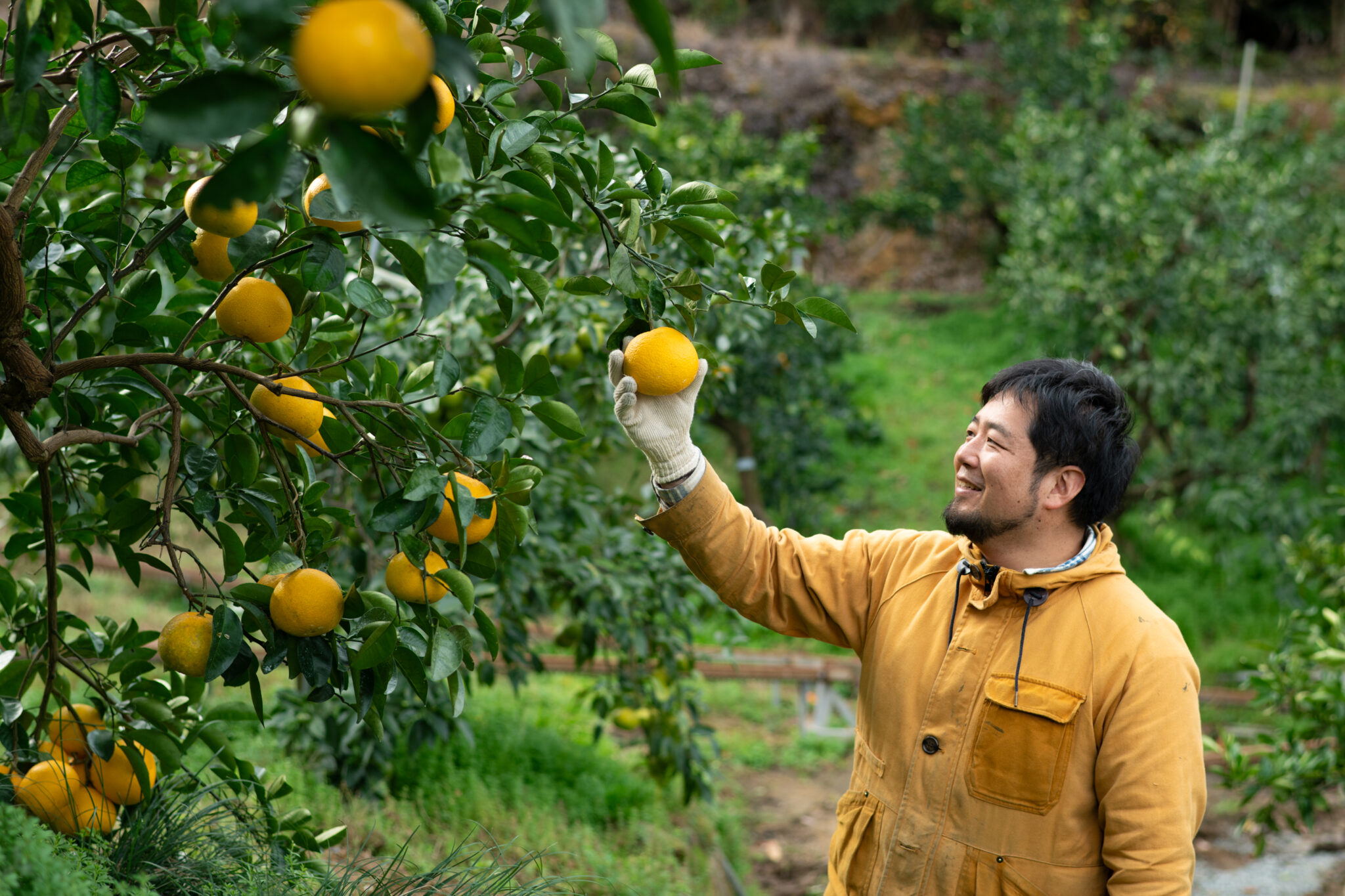Wakayama Prefecture is often referred to as the “Fruit Kingdom,” with a wide variety of fruits thriving throughout the year. In winter, citrus fruits, especially mandarin oranges, reach their peak harvest season.
Driving through Wakayama, you’ll find roads lined with citrus trees, their branches heavy with vibrant orange and yellow fruit.
To explore the roots of Japan’s citrus culture, we visited Kishu Hara Farm in Tanabe City, a farm renowned for cultivating a diverse range of citrus varieties. We also stopped by Bar Oct., to try out their citrus-based drinks.
We spoke with the representatives of both to uncover more about the rich citrus culture of Wakayama.
Rising in popularity during the Edo Period; The history of Wakayama mandarin oranges
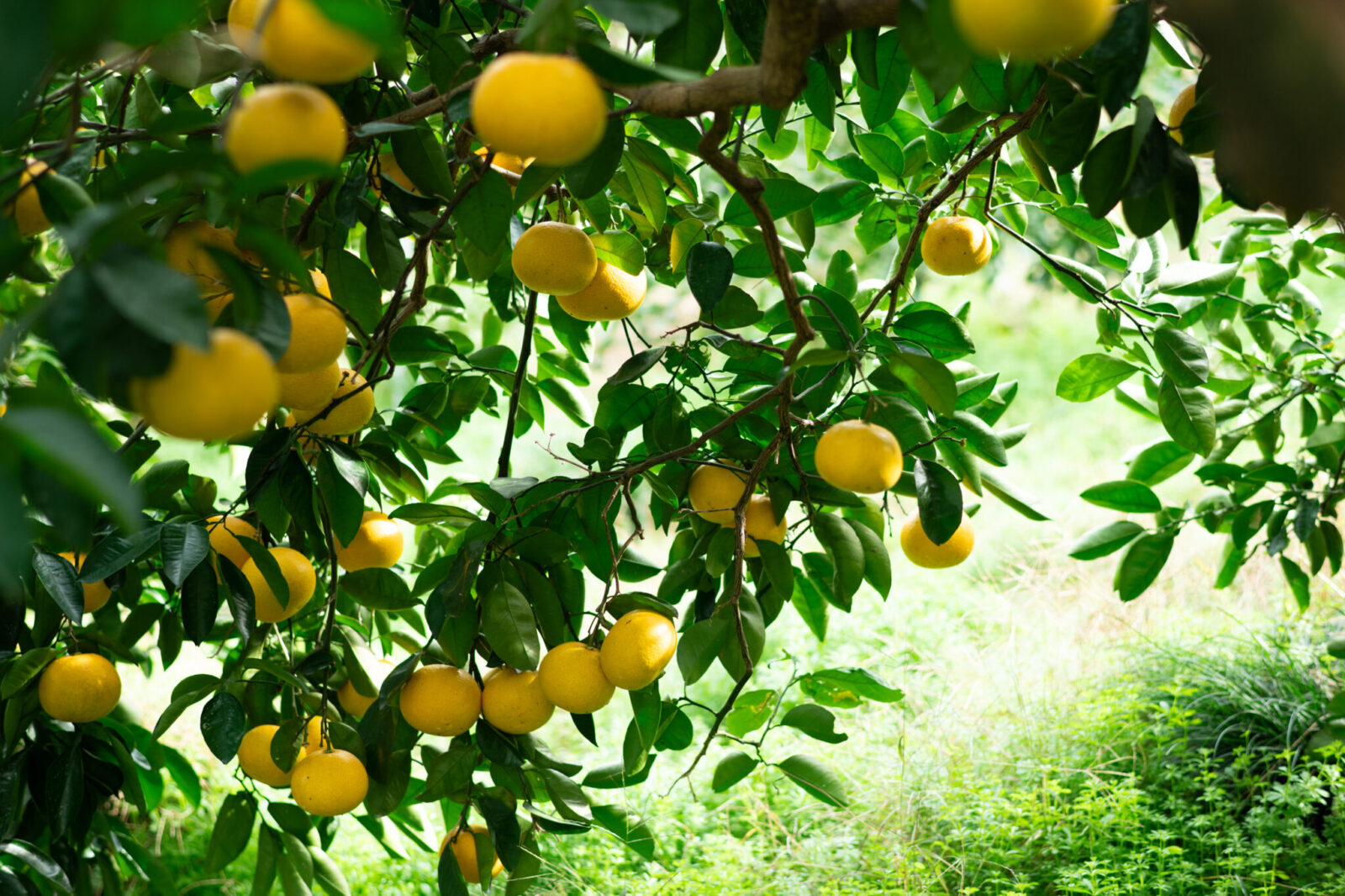
Mandarin oranges are a beloved and familiar fruit in the daily lives of Japanese people. Wakayama Prefecture, with its mild winters and warm climate, is Japan’s leading producer of mandarin oranges.
Much of Wakayama is part of the Kii Peninsula, surrounded by the ocean and covered with forests and mountains, which make up 77% of its land area. With little flat land, the mountains extend close to the coastline, creating a unique topography that provides the ideal balance of moisture and dryness for mandarin orange cultivation.
Looking up at the mountains, you’ll see vast slopes covered with mandarin orange orchards, supported by intricate stone walls resembling terraced rice fields. It is said that the pioneers of these orchards painstakingly cleared the rugged slopes and carried stones by hand from the Arita River basin to build these walls. Today, they stand as a testament to the immense labor and dedication of those who first cultivated the land.
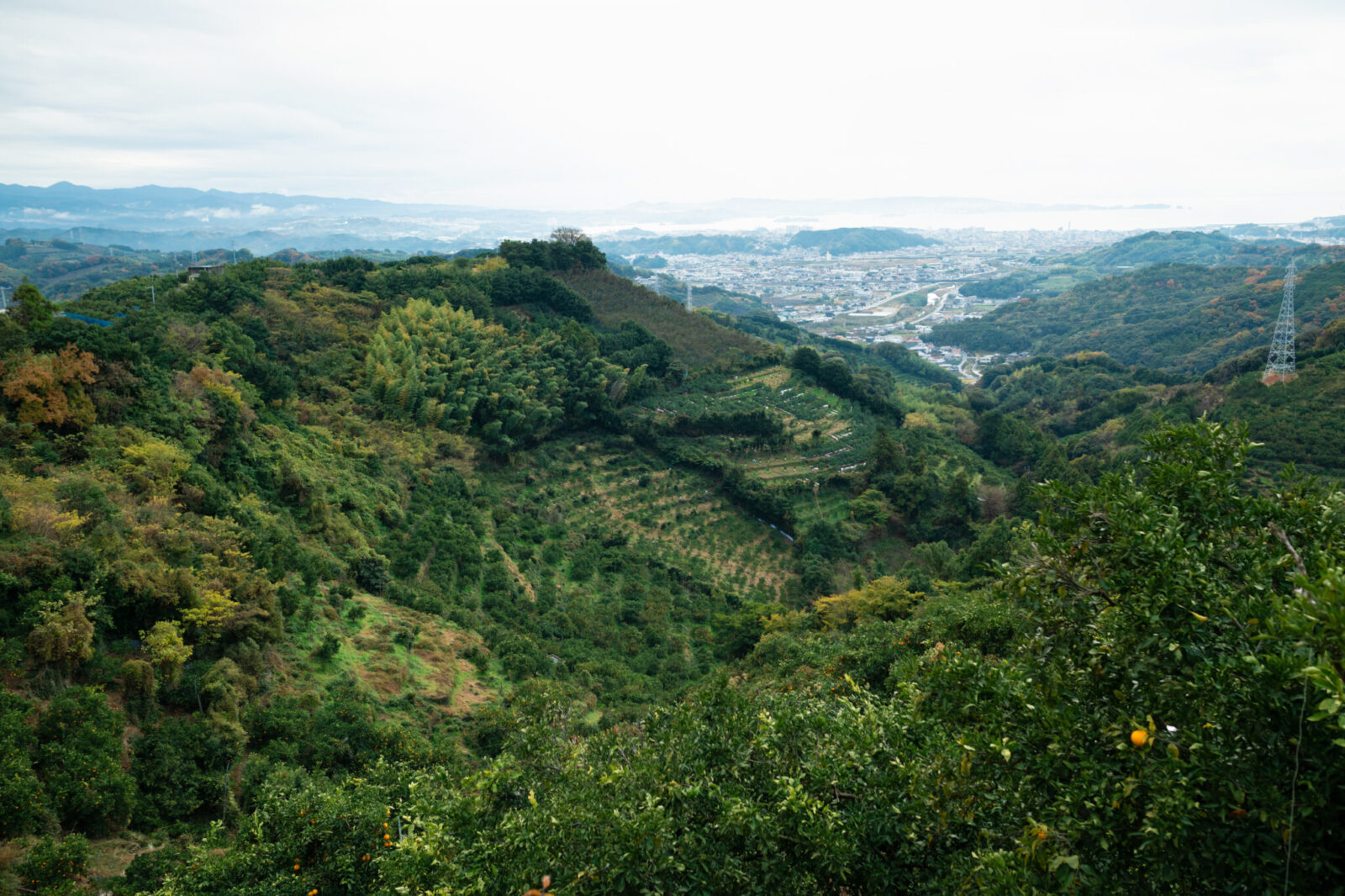
The history of mandarin orange cultivation goes back a long time in Wakayama. It is said to have existed in the Muromachi Period (1333-1573) and the word mikan (mandarin oranges) can be found in ancient records kept at a shrine in Arita City. During the Edo Period (1603-1868) the first lord of the Kishu domain named Yorinobu Tokunaga encouraged its cultivation and popularized the fruit.
In 1634, shipments of mandarin oranges began arriving in Edo, where they quickly gained popularity for their exceptional flavor. One of the most successful merchants of the Edo Period, Kinokuniya Bunzaemon, is said to have made a vast fortune through the mandarin orange trade. His bold and extravagant lifestyle became so legendary that it inspired books and even Kabuki plays.
At the time, mandarins with many seeds were believed to bring good fortune, symbolizing prosperity and a large family. It was said that samurai avoided eating seedless mandarins for this reason.
Today, Wakayama’s deep-rooted citrus culture is evident in its bustling local markets. A dazzling array of yellow, green, and orange fruits fills the space, creating a vibrant, almost mesmerizing scene.
Citrus sections are displayed by farmer’s name, showcasing an impressive variety of farmers. It’s impossible not to feel a surge of excitement when surrounded by rows upon rows of these vitamin-packed fruits.
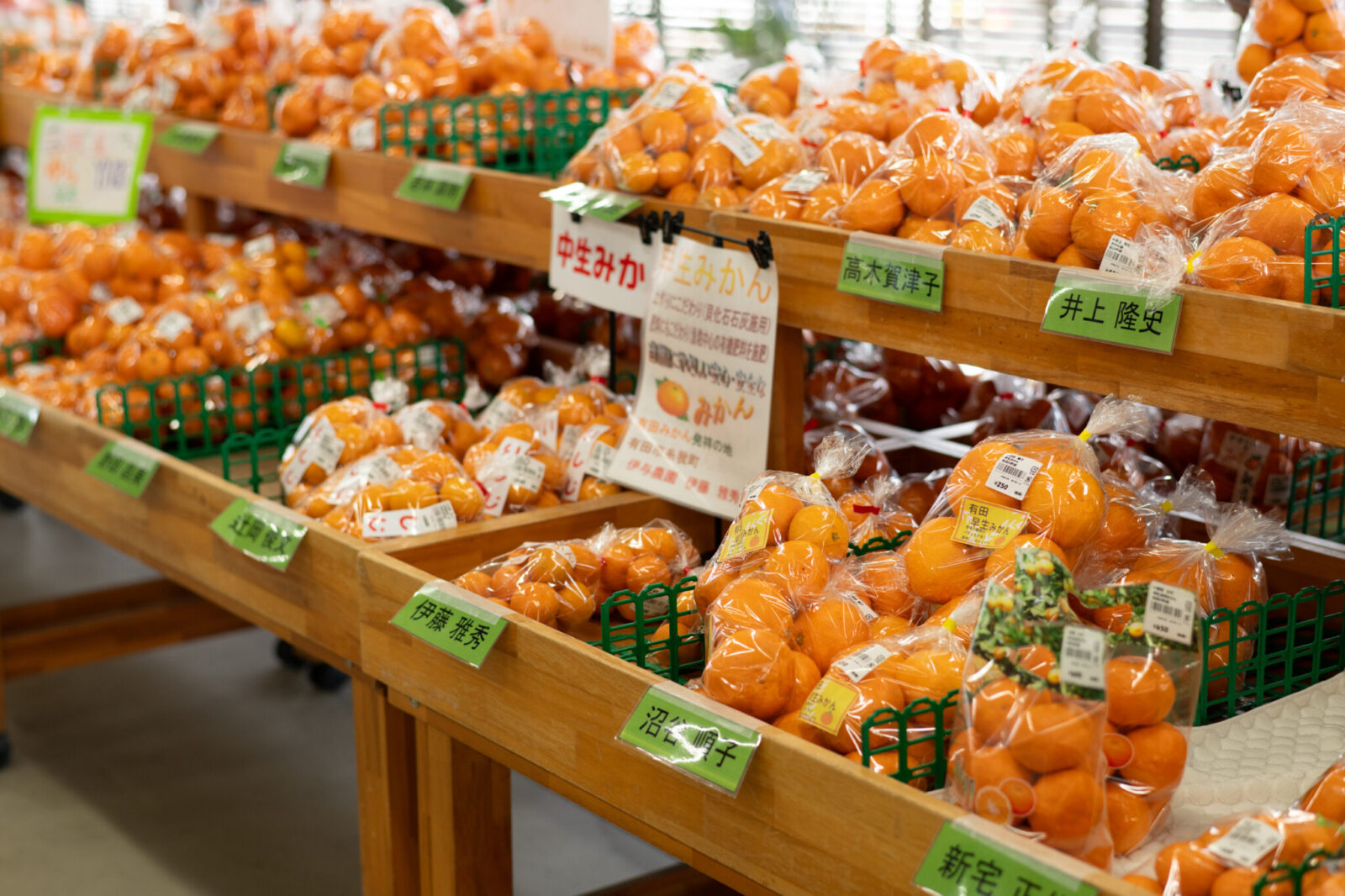
Generational citrus farmers that have existed since the Edo Period cultivate multiple varieties of citrus
Kishu Hara Farm is nestled in the mountains of Tanabe City, Wakayama Prefecture. Takuo Hara, the seventh-generation head of the farm, carries on a legacy that dates back to the Bunsei Era of the Edo Period (1818–1830).
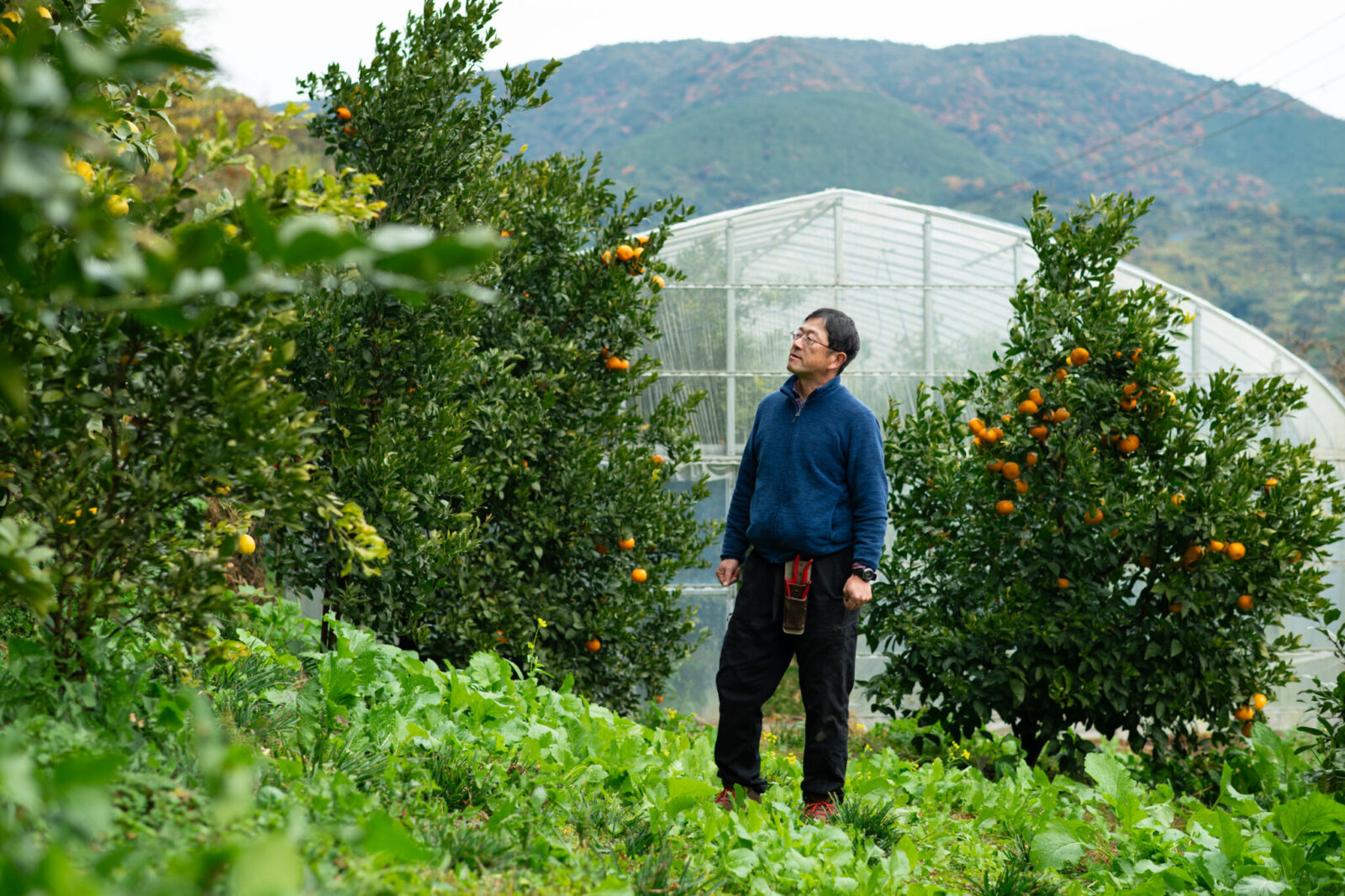
Before World War II, Hara says the farm also cultivated kumquats (kinkan) and exported them overseas. After the war, the southwestern region of Japan—mainly along the Seto Inland Sea coastline, as well as the Shikoku and Kyushu regions—was designated for large-scale production of Onshu mandarin oranges.
In Tanabe City, ume (Japanese plums) have also been widely cultivated since around the same period as mandarins. When the price of Onshu mandarins drastically dropped for a time, many farmers shifted their focus to ume production. Today, many farmers in the area where Hara Farm is located are diversifying their crops, primarily basing their businesses on three key pillars: Onshu mandarins, ume, and other citrus varieties.
“There is a popular resort in Shirahama,” Hara explains, “so there is a strong year-round demand for citrus fruits from tourists, hotels, and restaurants year round.”
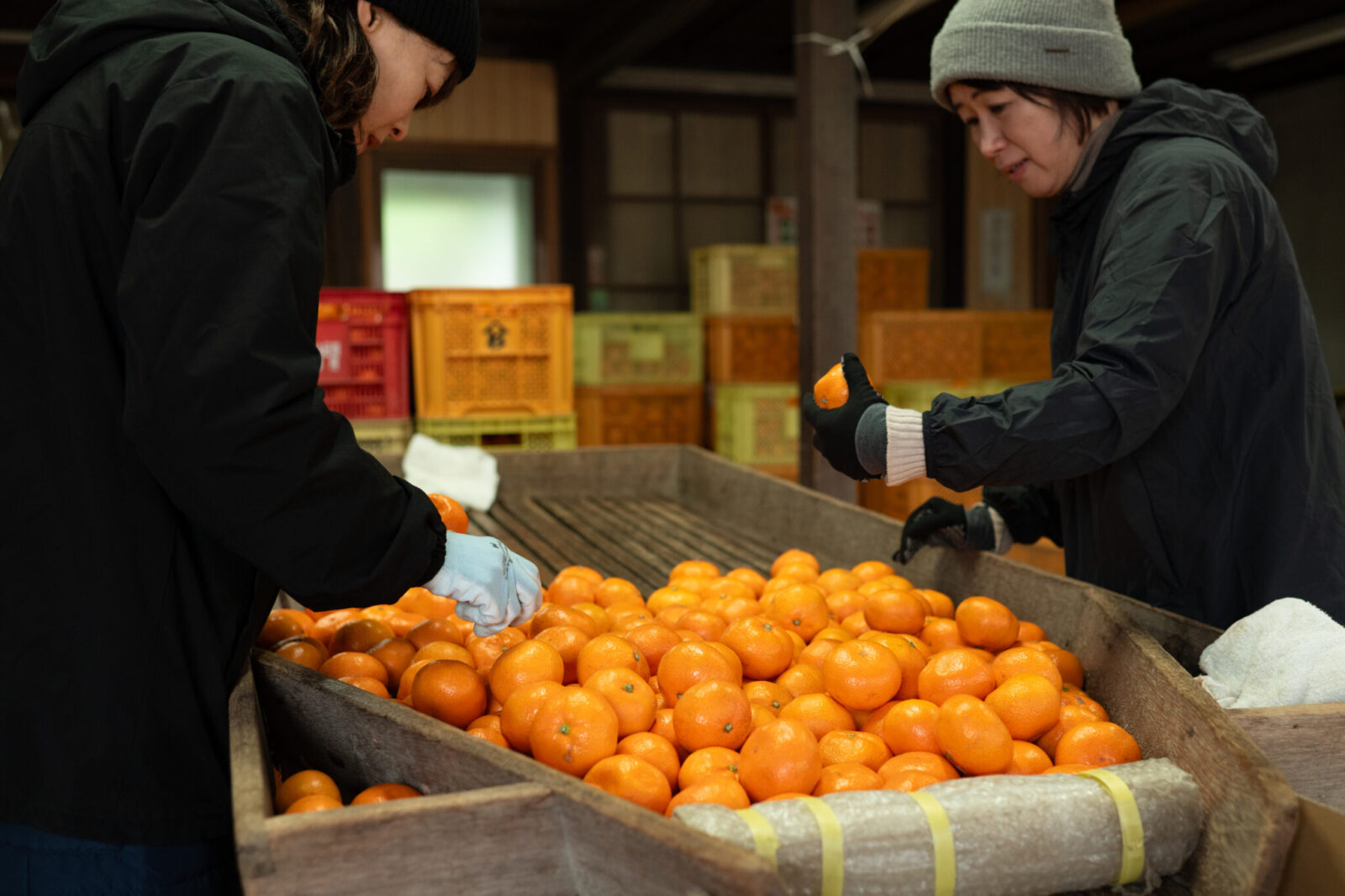
Hara spent his school years in the Kanto region but returned to his hometown to take over the family farm after graduating.
“When I was young, all I could think about was how to get away from the countryside. I was in Tokyo during the height of the economic bubble, so I had a lot of exciting experiences. Back then, finding a job was easy, but seeing how much my father genuinely enjoyed working on the farm sparked my own interest. Around the same time, the internet was becoming more accessible, and I realized that information was no longer limited by location. That’s when I decided to return home to the countryside and my family’s farm.”
Each citrus fruit has its own appeal
“One of the most popular citrus fruits today is the finger lime, known for its fun, crunchy texture. Ten years ago, the only finger limes available in Japan were imported from the U.S., making them both frozen and extremely expensive. We were one of the first farms to start cultivating them in Japan.”
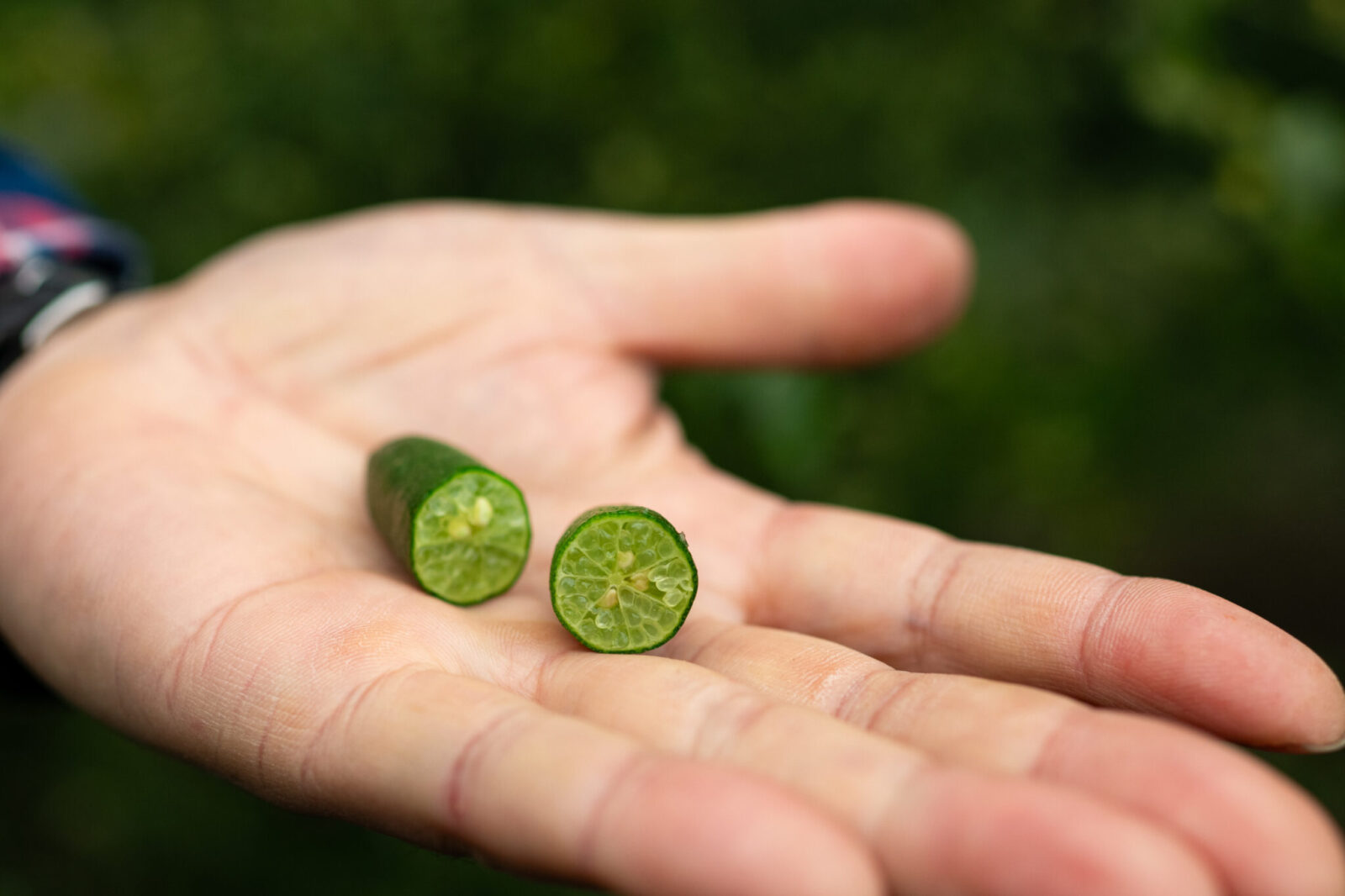
“This is called the Buddha’s Hand Citron. It is highly sought after in the Kansai market, with its nicely shaped fruit often used as decorations for New Year’s celebrations and tea ceremonies. Additionally, its fragrant zest is a prized ingredient in restaurants. This unique citrus is considered one of the closest varieties to the original lemon.”
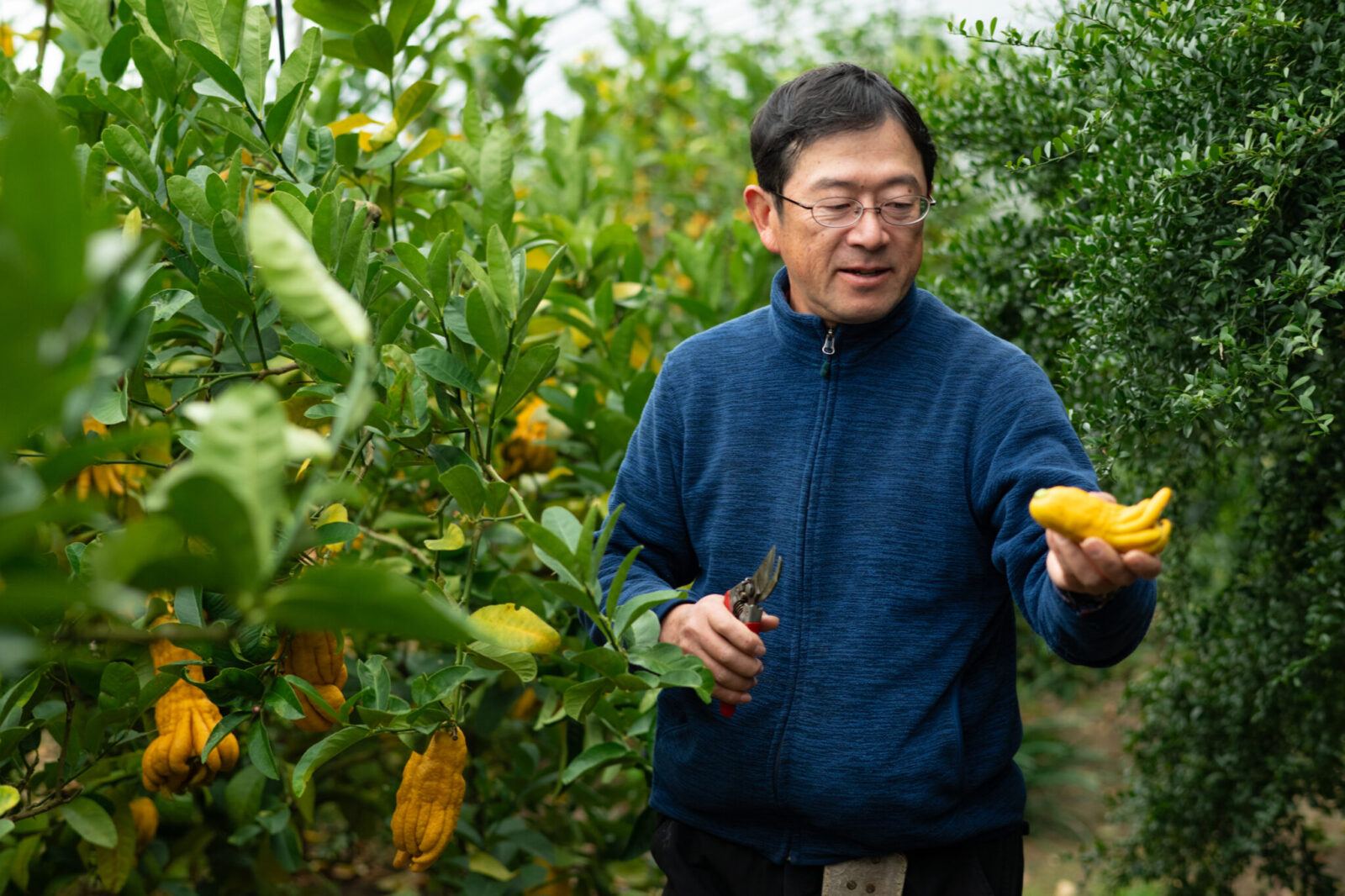
Hara is like a researcher, meticulously explaining each citrus variety in front of its respective tree while cutting fresh slices for us to taste. When we smelled the leaves of the Buddha’s Hand Citron, we were surprised by its unexpectedly cool and refreshing aroma.
His farm is home to an impressive array of citrus, including navel oranges, hassaku, kobumikan, bergamot, sweetie, and many other citrus varieties. Walking through the expansive orchard feels like wandering through a living citrus museum—Hara has planted every variety he could get his hands on.
With over 70 different citrus varieties growing on his farm, even Hara himself is unsure of the exact number of trees he has. However, his motivation extends beyond commercial farming; he cultivates these diverse varieties to ensure their preservation.
Despite the sheer number of trees he tends to, he spares no effort in their care, following environmentally friendly farming practices that allow the trees to grow as naturally as possible. His dedication has earned him an Eco Farmer certification.
While this region has long been known for its diverse citrus cultivation, Hara chose a different approach. Rather than mass-selling Onshu mandarin oranges on a national level, he focused on developing direct and lasting relationships with his customers. As he tailored his harvests to meet their needs, the variety of citrus he grew expanded. This expansion accelerated even further when he began working closely with restaurant chefs, responding to their requests for unique and high-quality citrus varieties.
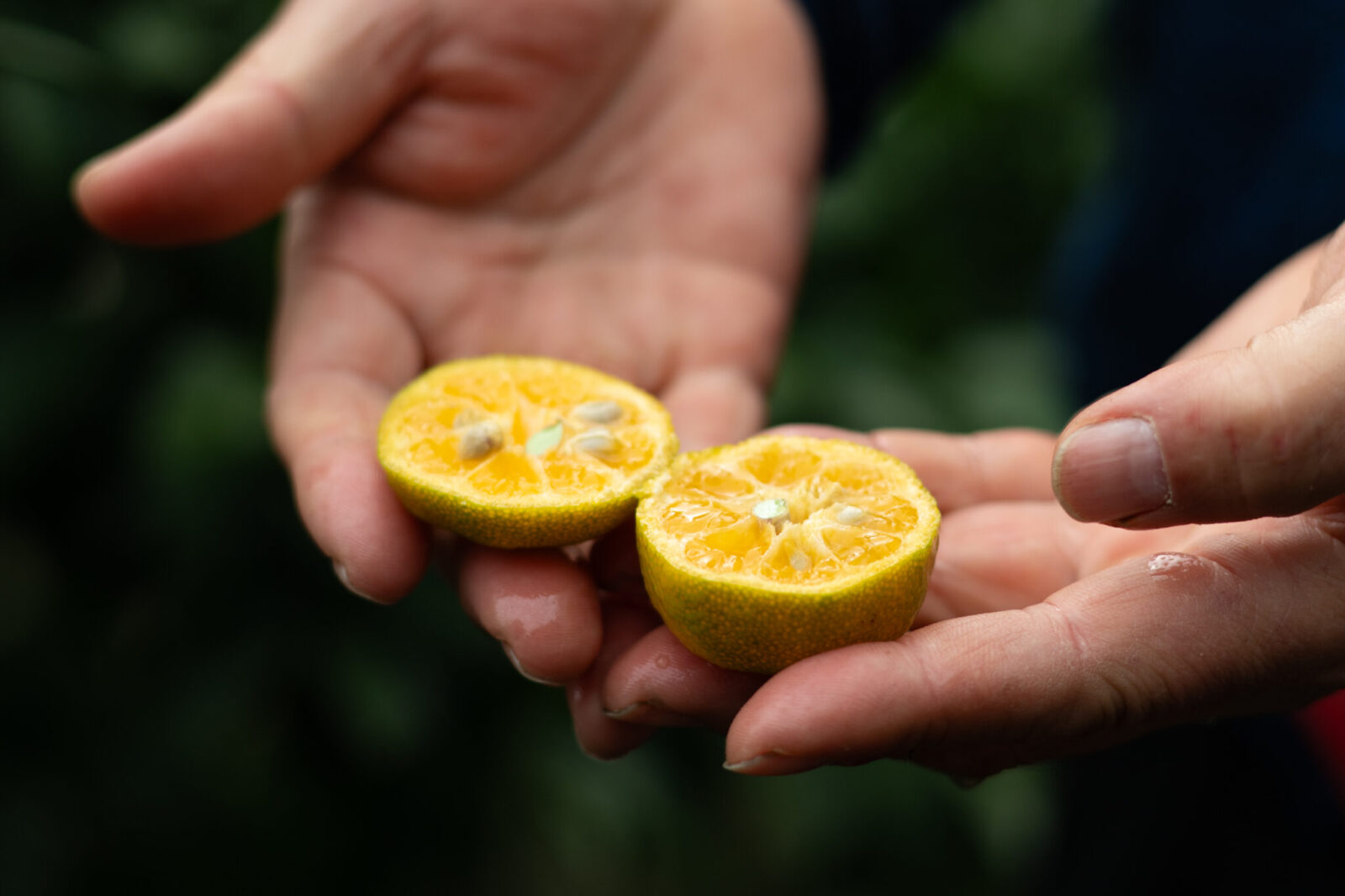
“There was a prefectural initiative aimed at connecting farmers with restaurant chefs, where they organized farm tours for chefs to visit the farms firsthand. Through that program, a few chefs took a liking to our farm, and from there, word spread among the culinary community.”
“One French chef working in Japan asked if we grew any Western varieties of citrus, which prompted us to expand our selection. From that point on, our range of citrus just kept growing.”
As word continued to spread, chefs from around the world—including those from renowned Michelin-starred restaurants—began visiting the farm. Hara cultivated strong business relationships with each restaurant, prioritizing long-term partnerships built on trust and quality.
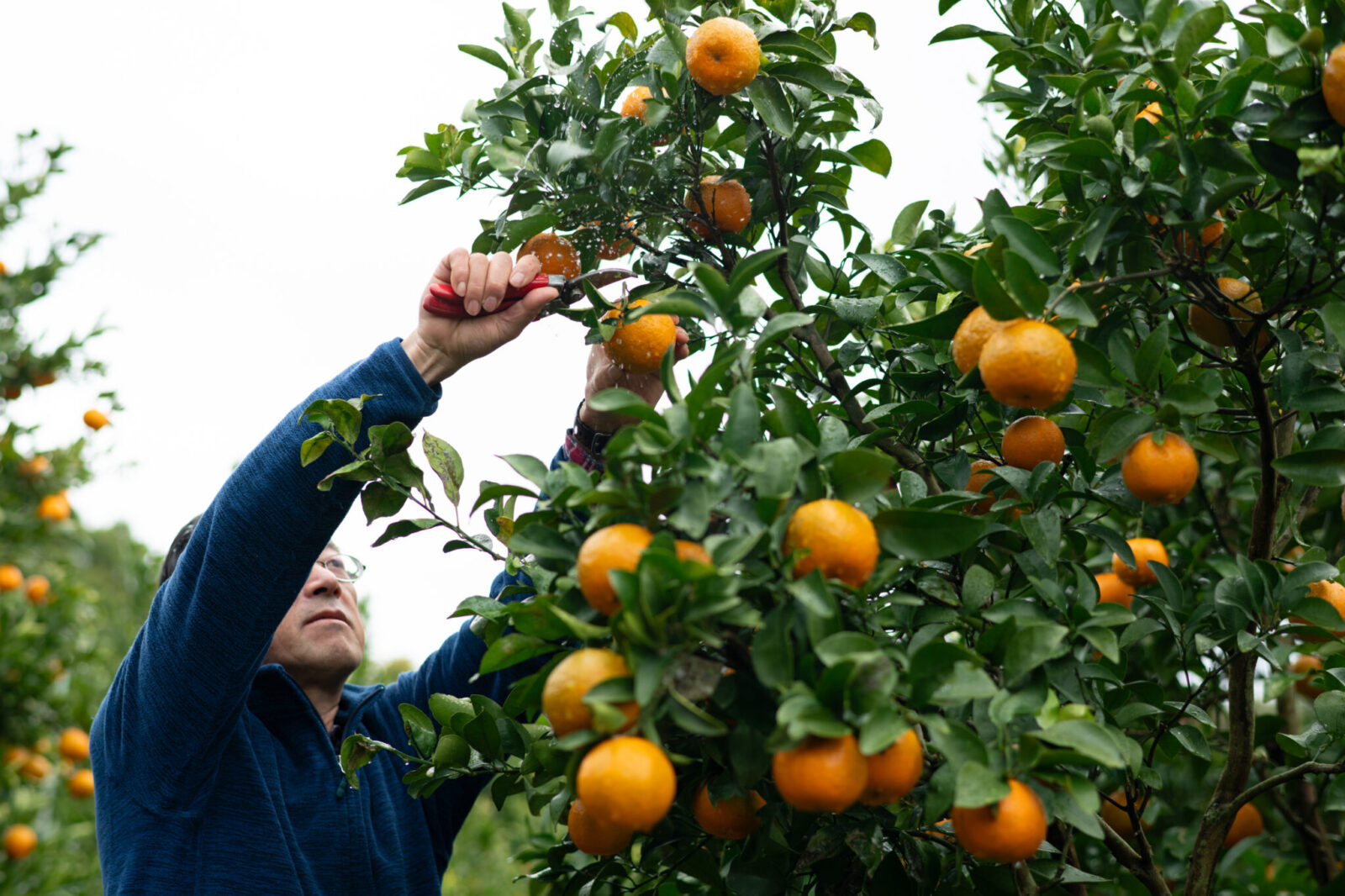
Hara and his friends opened up an open facility called the Akizuno Garten in a closed down elementary school near his farm. In one corner of this facility, they have a shop called Valencia-Batake that sells desserts and jams made out of citrus fruits.
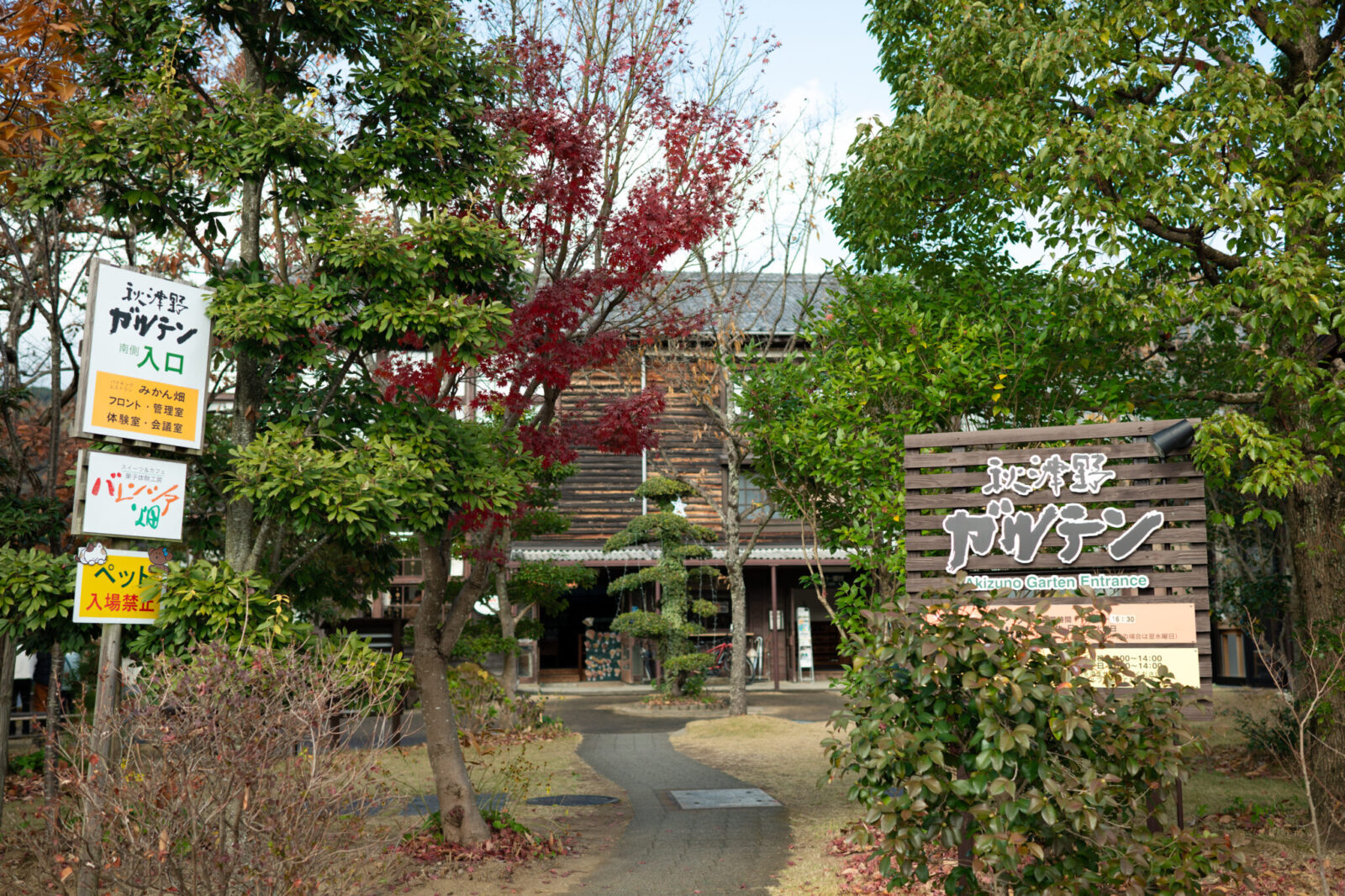
The facility also hosts a variety of citrus-themed workshops, including baking sweets, making aroma oils, and natural dyeing. On the second floor, there is a handcrafted citrus museum curated by local residents, featuring an extensive and detailed collection of citrus-related exhibits. The displays are both educational and engaging, making them enjoyable for visitors of all ages, including children.
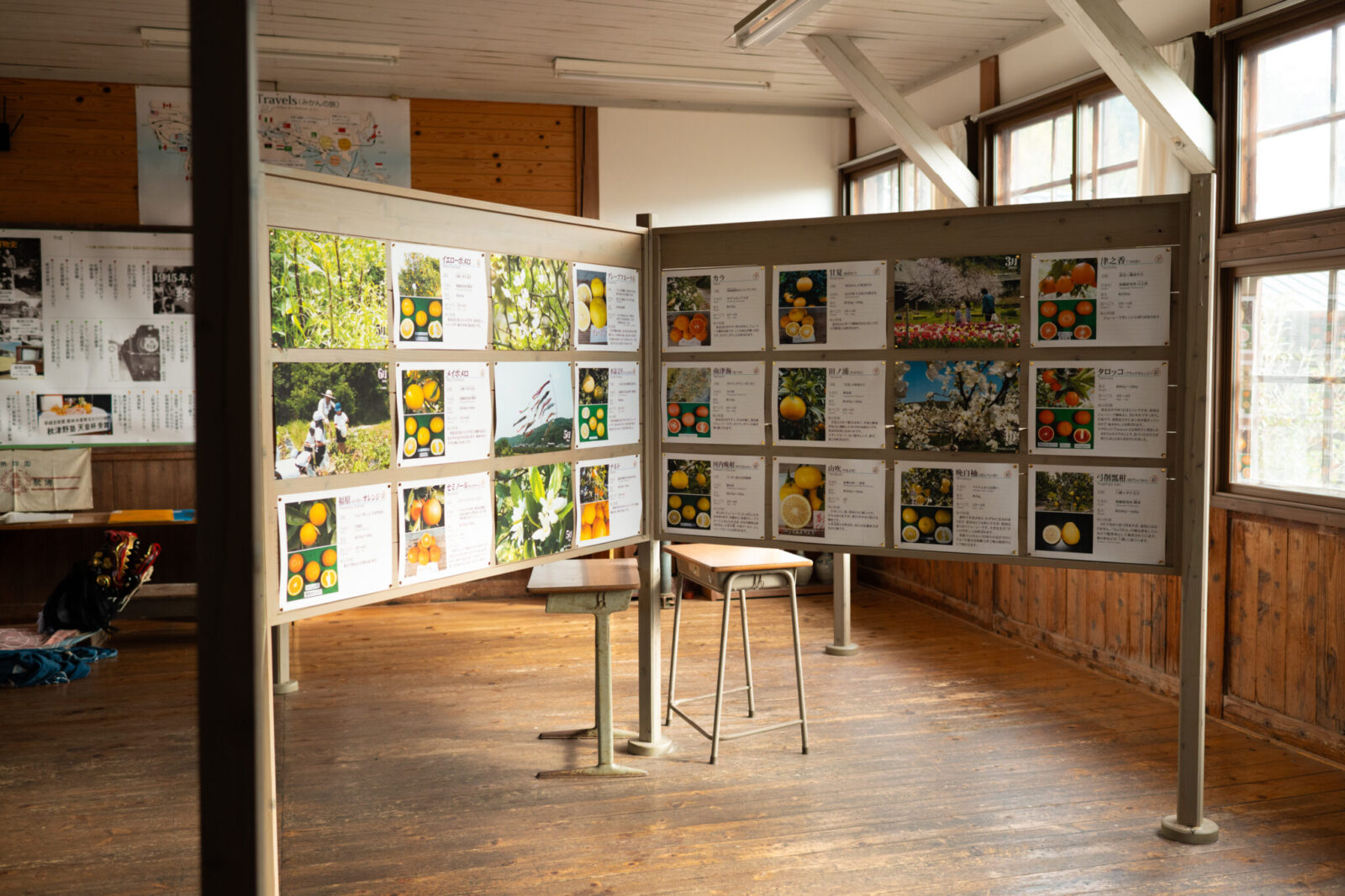
There is also a farmer’s restaurant on the premises where they serve incredibly delicious freshly squeezed mandarin orange juice.
Hara says his mission is to raise awareness on the many varieties of citrus fruits in the world and allow people to enjoy the unique characteristics of each.
“To be honest, growing so many different kinds of citrus is a lot of work, but that’s exactly why I need to enjoy it as much as possible. People often ask me which variety is my favorite, but I see myself like a school teacher—I don’t pick favorites,” he says with a smile.
“Each fruit has its own unique role. Some are best eaten fresh, while others shine in cooking. Even those with strong, distinct characteristics have their place in the world. If not, they won’t survive. The beauty and fascination of citrus lies in these differences.”
Hara jokes happily as he talks about each citrus fruit as if it were his own children.
As we taste the citrus fruits that come in various colors, shapes and aromas and listen to Hara introduce them one by one, we are reminded by the famous quote by Misuzu Kaneko, “We are all different and we are all special.”
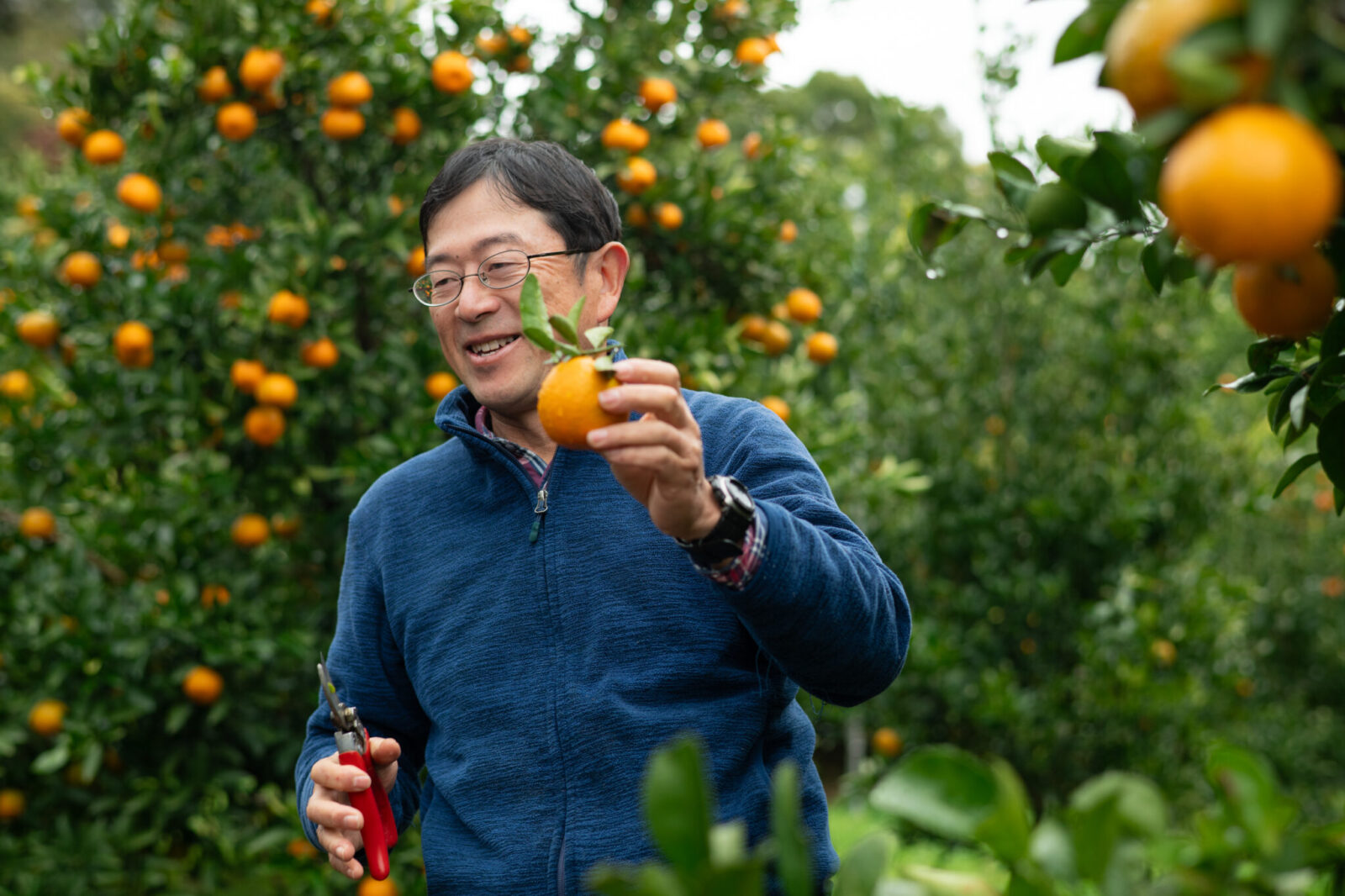
Grass cultivation that provides benefits to both humans and the citrus trees
When we talk about mandarin oranges in Japan, we are usually referring to Onshu mandarin oranges. As the most widely consumed variety, their easy-to-peel skin makes them a staple in Japanese households.
“Cultivation of Onshu mandarin oranges is especially popular in Wakayama, but in reality, there are over a hundred different varieties of them. Here on our farm, we cultivate about nine different kinds.”
Shinya Matsusaka, a third-generation farmer at Matsusaka Farm, guided us through his citrus orchards.
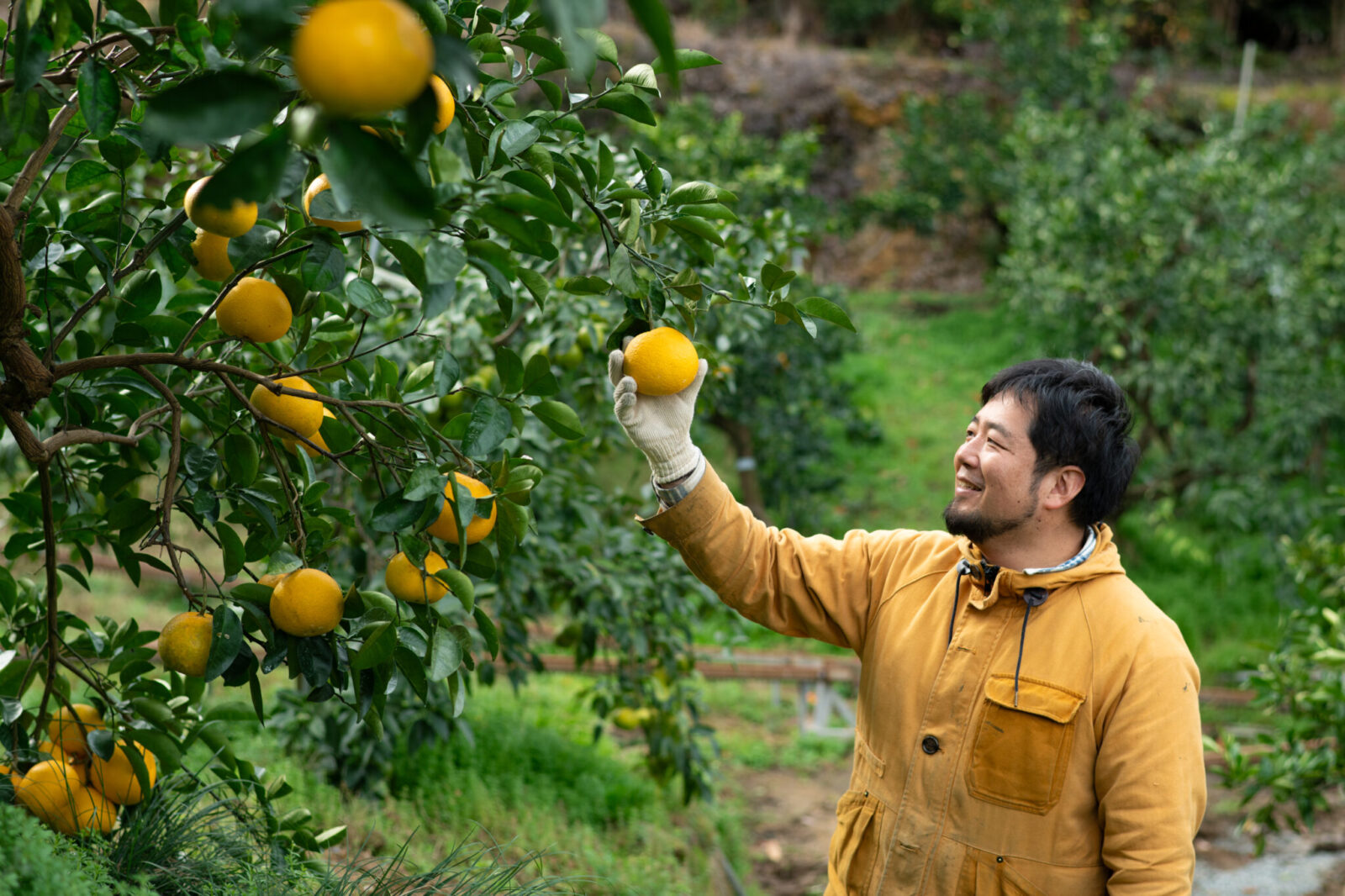
“After harvesting Onshu mandarin oranges in December, we move on to varieties like Iyokan, Dekopon, and other late-season citrus, which ripen from January to May. There are so many varieties that it’s hard to keep count.”
Because different citrus varieties ripen throughout the year, farmers stay busy year-round. This extended harvest season allows Wakayama residents to enjoy fresh citrus almost all year long.
At Matsusaka Farm, they practice a cultivation method that encourages grass growth in the orchards to help maintain healthy soil.
“For most of the year, our orchard floor stays covered in greenery. But that doesn’t mean we let just any weeds grow freely. Take this soft, delicate grass, for example—it’s called cleavers, and it’s actually edible. It belongs to the legume family, so it also helps replenish nutrients in the soil.”
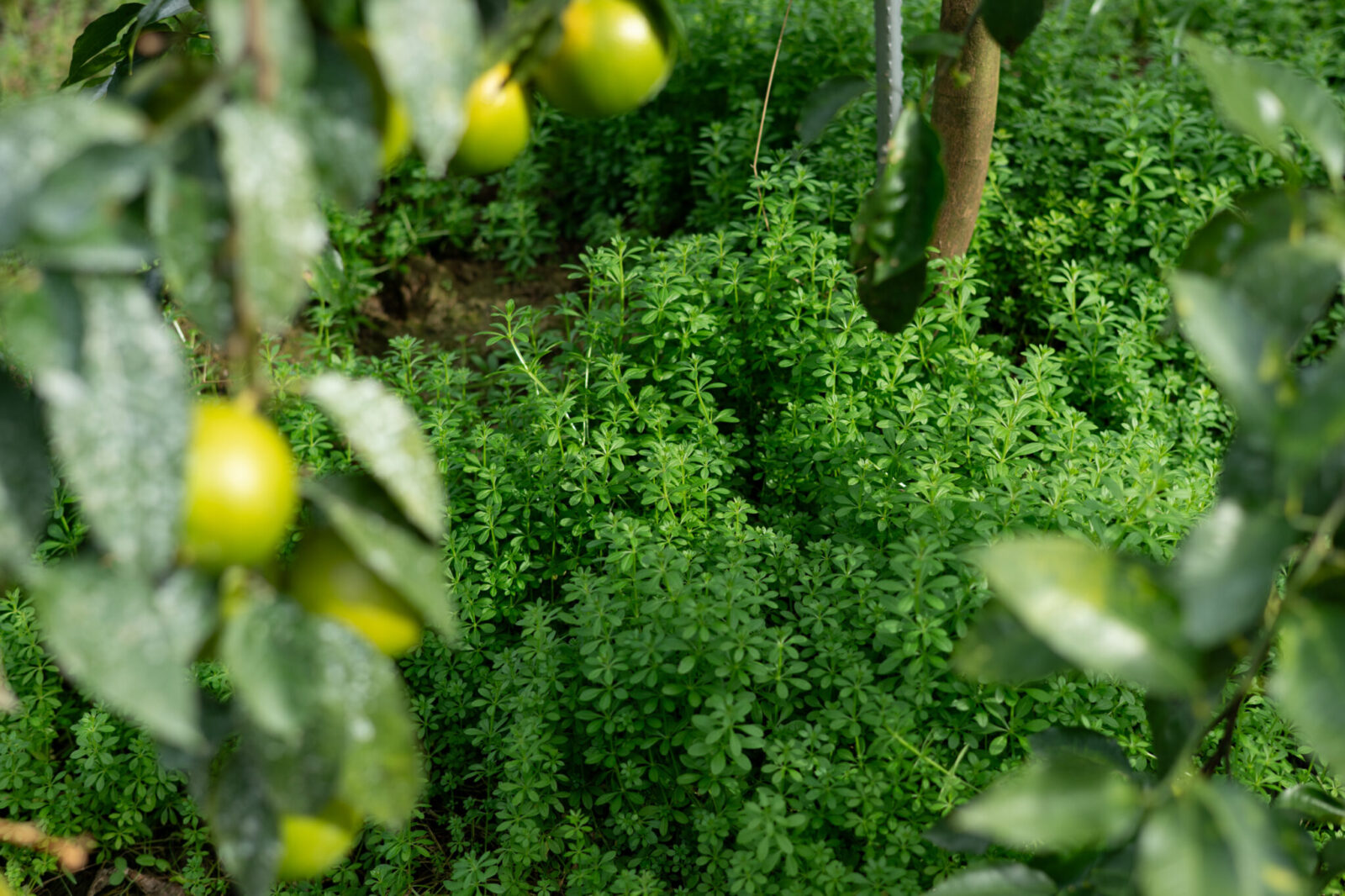
Other grass varieties include rattail fescue, phyla canescens, and kurapia—each carefully selected for its ability to support mandarin orange trees. Rather than allowing weeds to grow unchecked, the grasses are chosen for their specific roles in maintaining soil health and keeping maintenance work minimal.
“Natural farming actually requires a significant amount of labor in grass cutting. Working under the peak summer heat can be detrimental to our health, so we manage the environment in a way that reduces physical strain while also enriching the soil,” Matsusaka explains.
As he speaks, he digs into the earth, revealing soft, rich black soil, alive with beneficial microorganisms.
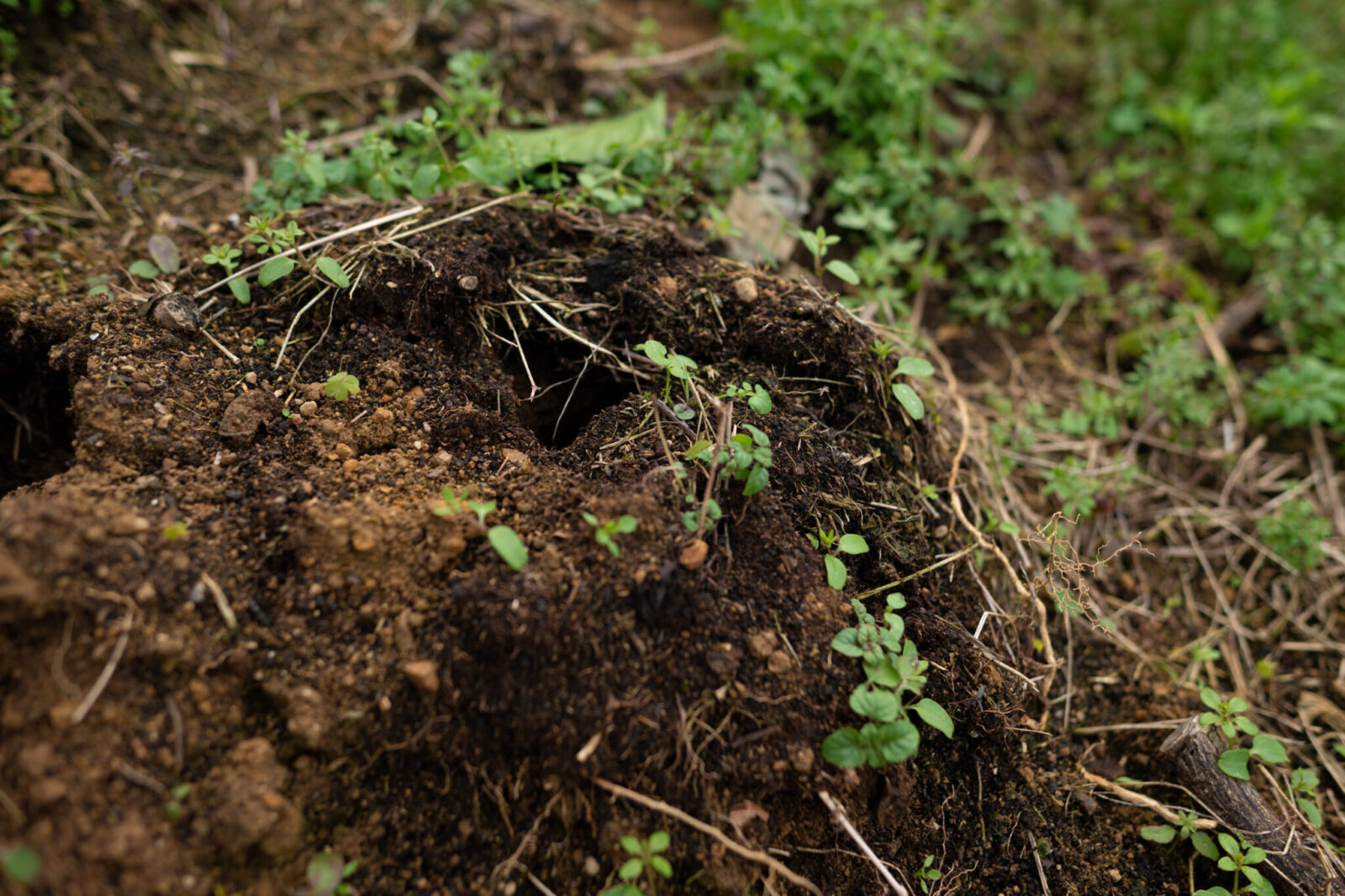
Passing on the delicious taste of childhood to the next generation
Matsusaka recalls growing up surrounded by delicious mandarin oranges, but he never envisioned himself becoming a farmer. Instead, he pursued marketing in university and later worked for an IT company in Kyoto. After quitting his job, he spent some time drifting without a clear direction—until he received news that his grandfather had fallen ill and the family farm needed his help.
“I started out with the simple idea of just giving it a try for a while. But I quickly realized I had completely underestimated farming. It was far more challenging than I expected, and to top it off, it didn’t generate much income. That’s when I began thinking about how we could make the business more sustainable. My background in marketing turned out to be very useful.”
The number of mandarin orange farmers continues to decline each year, with the aging farmer population presenting an ongoing challenge.
“Ten years ago, the average age of a farmer was already around 70, and people were saying it was the end of the road. But now, even farmers in their 80s are still working hard, producing oranges. While the overall number of farmers is shrinking, a few young farmers have stepped in to take over, managing to keep things running. However, the amount of land each person oversees is increasing rapidly.”
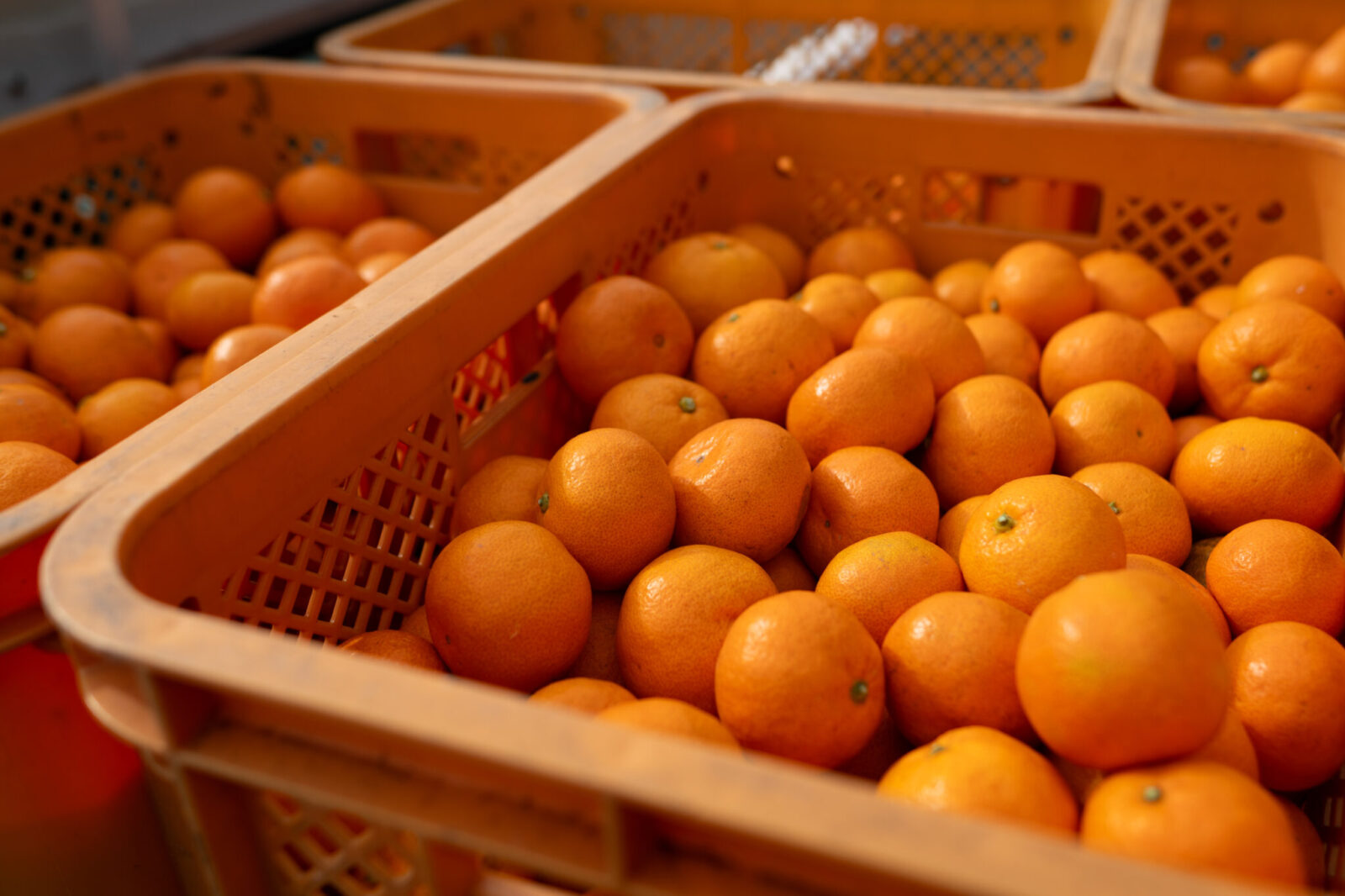
Mandarin orange farms are often situated on steep slopes, making the work both physically demanding and potentially dangerous. Tragically, an accident claimed the life of a farmer last year.
Efforts have been made to connect interested travelers with farmers as seasonal laborers, but Matsusaka notes that this is only a temporary solution and does not address the deeper issue of labor shortages. Attracting people to work in agriculture remains a significant challenge.
“That being said, the land here is so rich that simply planting citrus trees yields incredibly delicious mandarin oranges. Yet, because the work is inefficient, it’s heartbreaking to see such extraordinary land being abandoned. Even the fields known for producing Japan’s finest mandarin oranges share this same remarkable soil.”
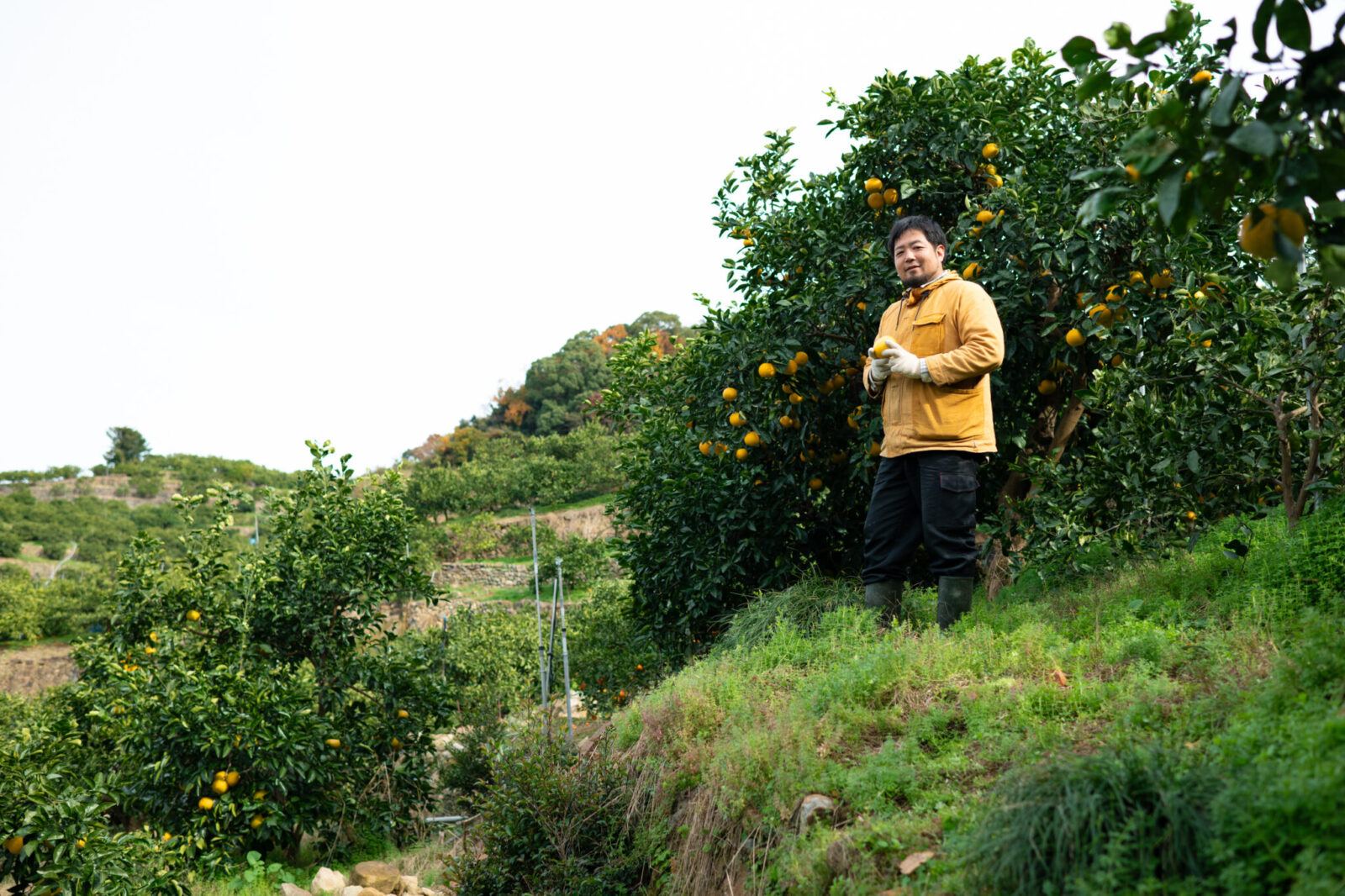
Another defining characteristic of Matsusaka’s farm is his approach to letting fruit fully ripen on the tree before harvesting. He says that his family has always produced ripe mandarin oranges in the past, simply because they could not keep up with the harvest.
One variety that has been gaining popularity in recent years is Yura Wase, a rare mandarin orange grown in a limited area. This variety is left to ripen on the tree for about one to one and a half months before being picked.
“Mandarin oranges are typically harvested while still slightly underripe and then stored to allow their acidity to mellow before shipping. This post-harvest ripening process has its own advantages. However, when the fruit ripens naturally on the tree, the sugar content increases as the plant continues to grow. The amino acid composition also develops differently compared to storage-ripened fruit, resulting in a deeper, more complex flavor. Our goal is to produce mandarin oranges with a rich taste and a perfect balance of sweetness and acidity.”
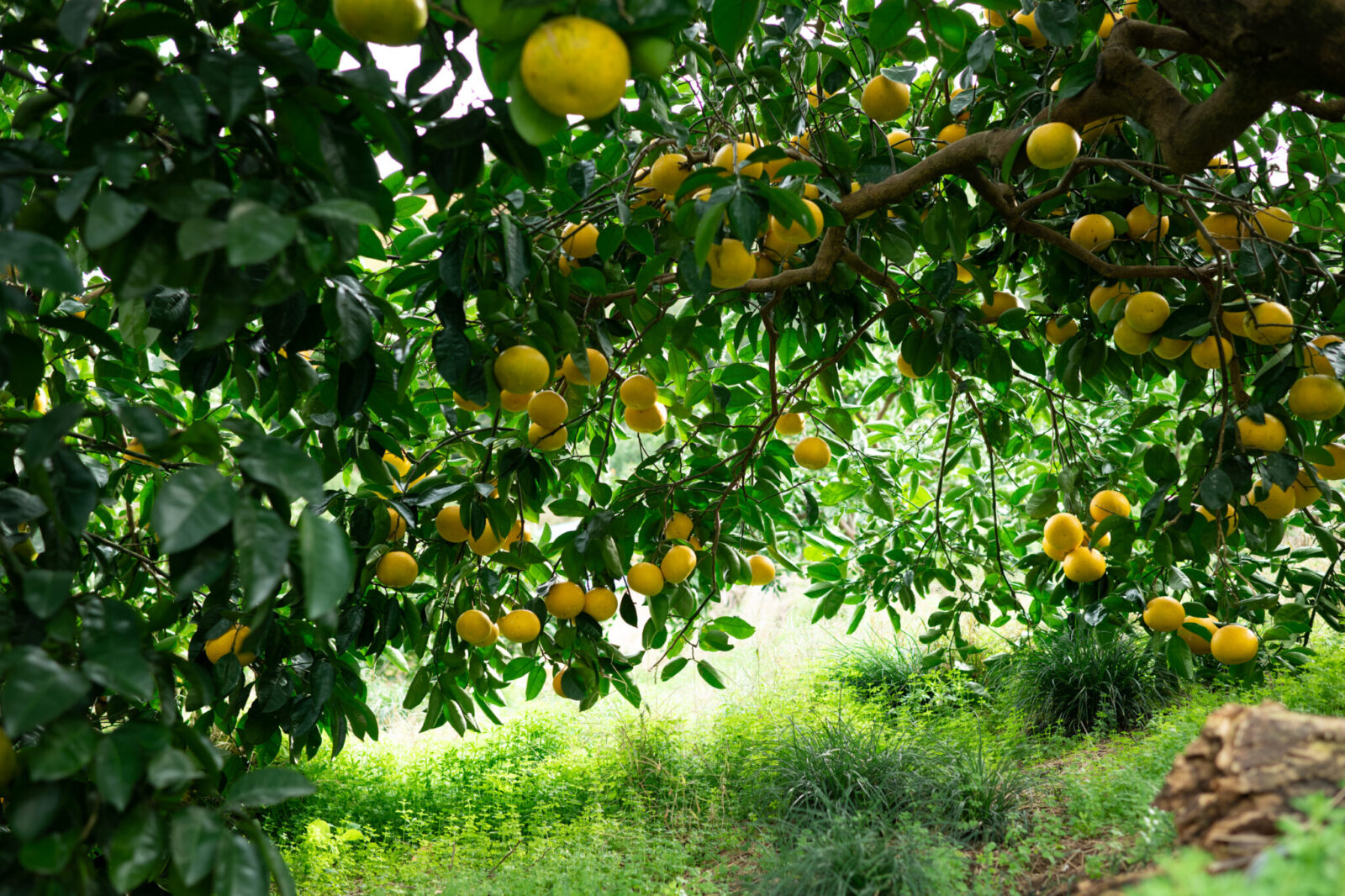
One of the biggest reasons Matsusaka chose to take over his family farm was because he wished to continue eating the delicious mandarin oranges he ate as a child.
With a desire to pass on these delicious mandarin oranges to the next generation, Matsusaka continues to care for his orchards.
Citrus as a great tool for communication
Near JR Kii-Tanabe Station, a bustling district is home to over two hundred izakaya (Japanese-style pubs) and bars packed into narrow alleyways. Bar Oct is a popular bar that serves various cocktails featuring the fruits in season.
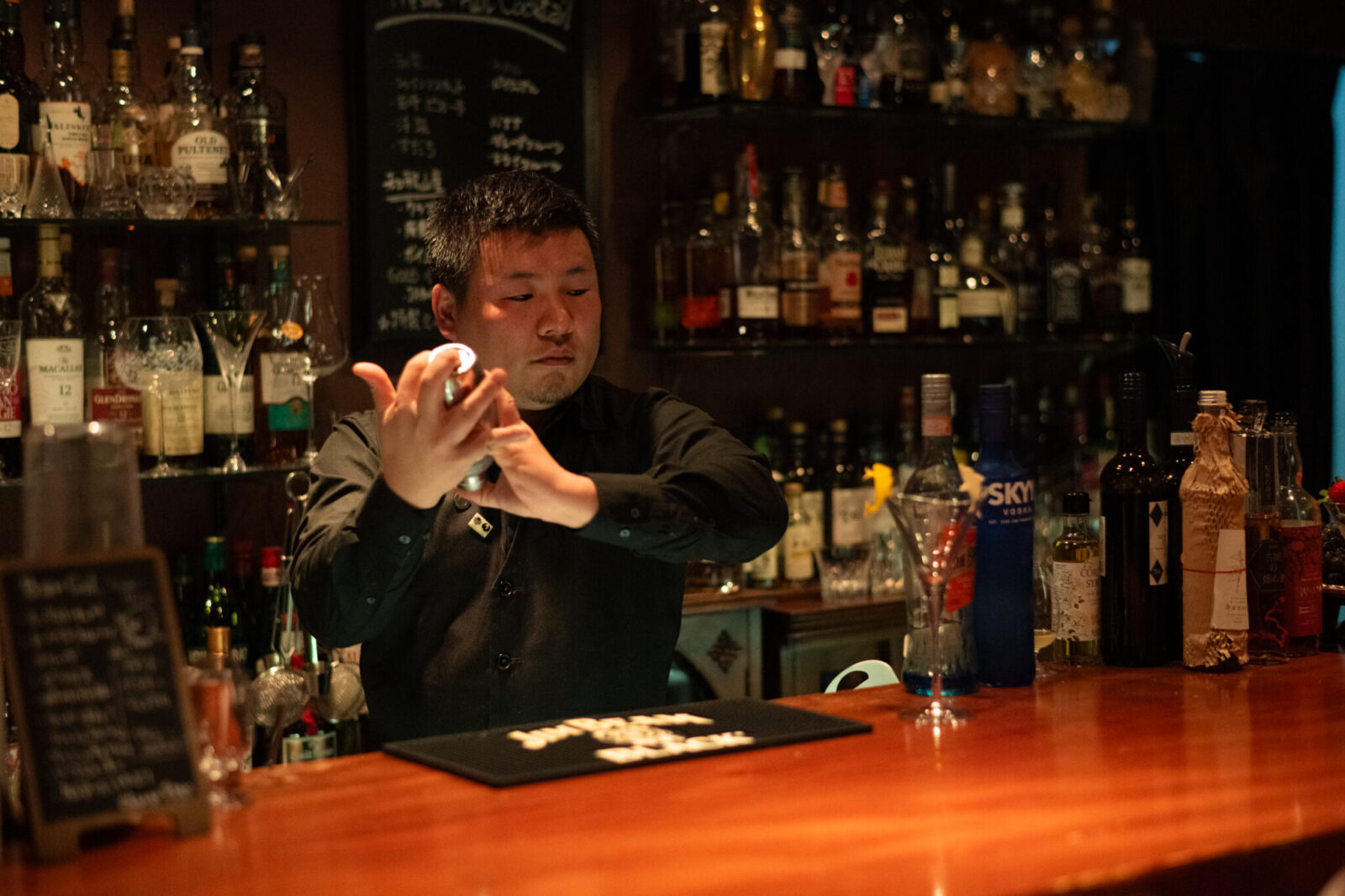
Owner and bartender Itaru Okamoto personally prepares everything on the menu, from food to desserts. During the coronavirus pandemic, when serving alcohol was restricted, he adapted by hosting afternoon tea sessions, creating a variety of sweets and baked goods.
With Wakayama Prefecture’s year-round abundance of fresh fruit, he always has high-quality ingredients for his cocktails.
“In winter, especially from February to March, I come up with endless cocktail ideas since it’s peak citrus season,” he says. Rather than following a set menu, he prefers to talk to customers and craft drinks tailored to their preferences on the spot.
“Tanabe is also close to the sea, so sashimi platters are a popular choice. But in winter, we can also serve citrus platters. I think it’s fun to enjoy a variety of fresh fruits and fruit drinks.”
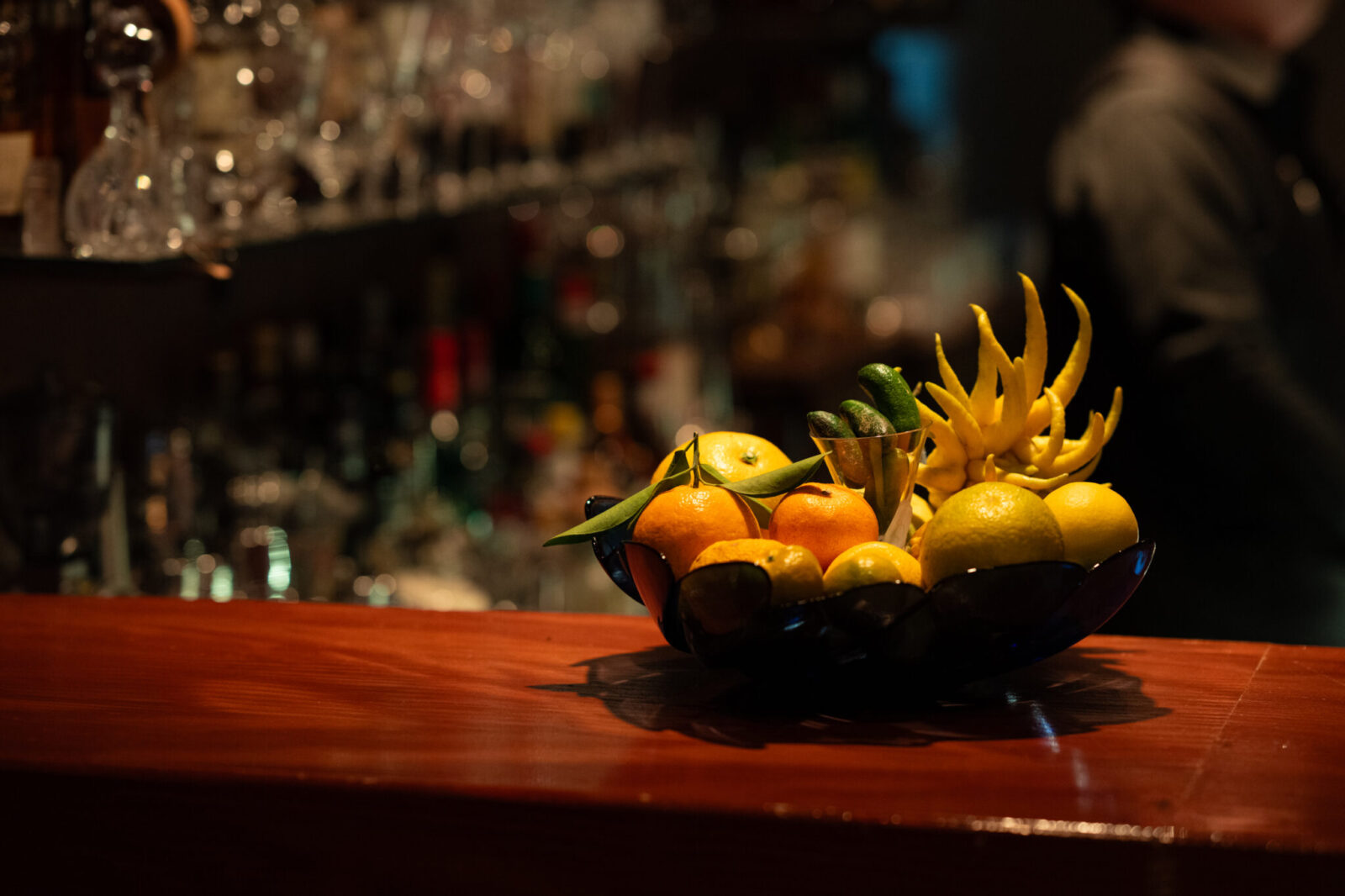
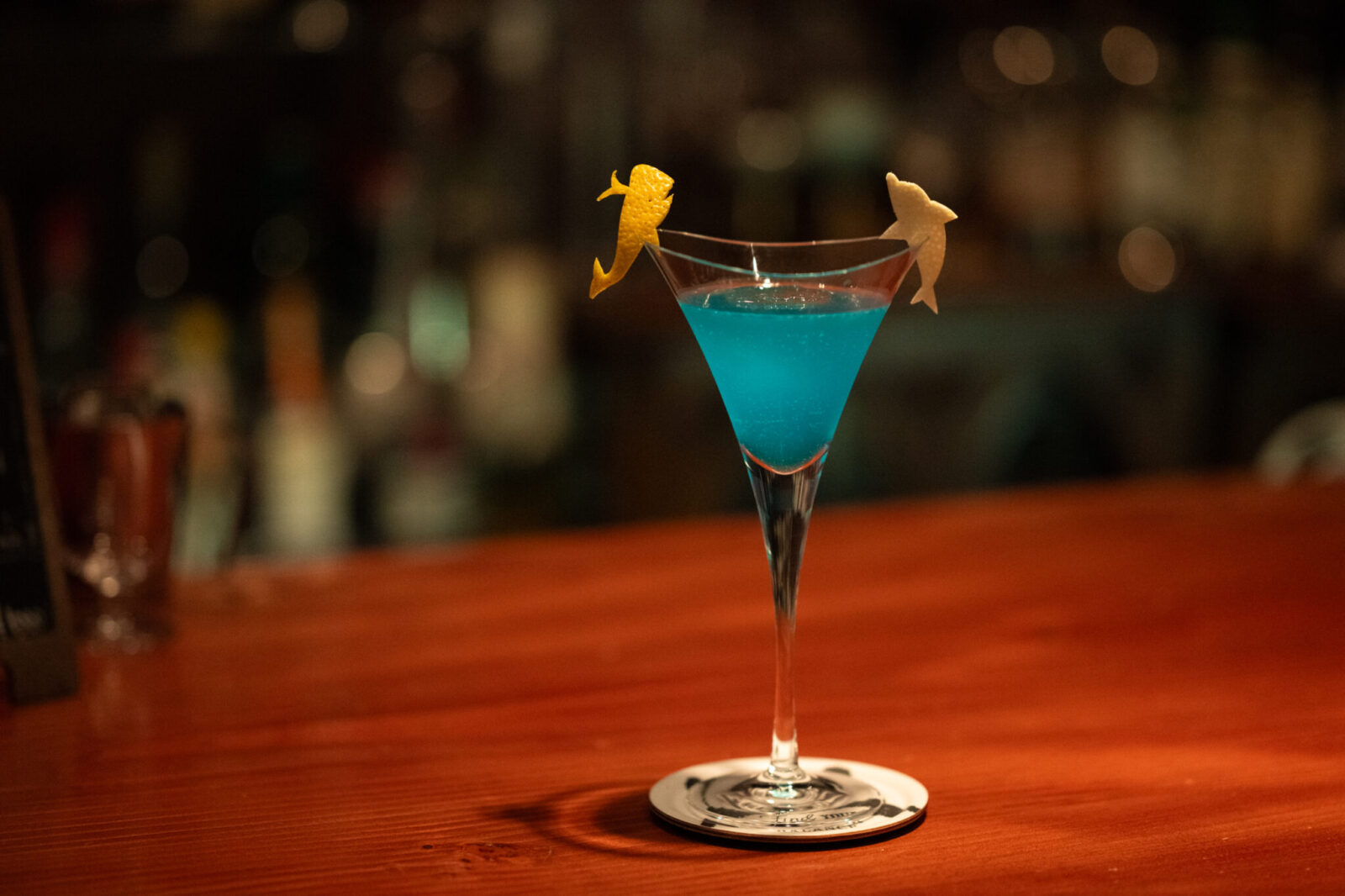
Okamoto has a close relationship with both Hara Farm and Matsusaka Farm, and some of the citrus fruits in his fruit basket that day were sourced from their orchards.
As we chatted casually, Okamoto crafted a cocktail using a rare citrus fruit, Jabara, grown in Kitayama Village in Wakayama Prefecture. The cocktail combined blue curaçao and vodka with Jabara juice, resulting in a vibrant sea-like color. He also prepared a hot yuzu vanilla milk tea, which he said was inspired by a conversation with a farmer who mentioned that he could smell a hint of vanilla in the peel of his yuzu fruits.
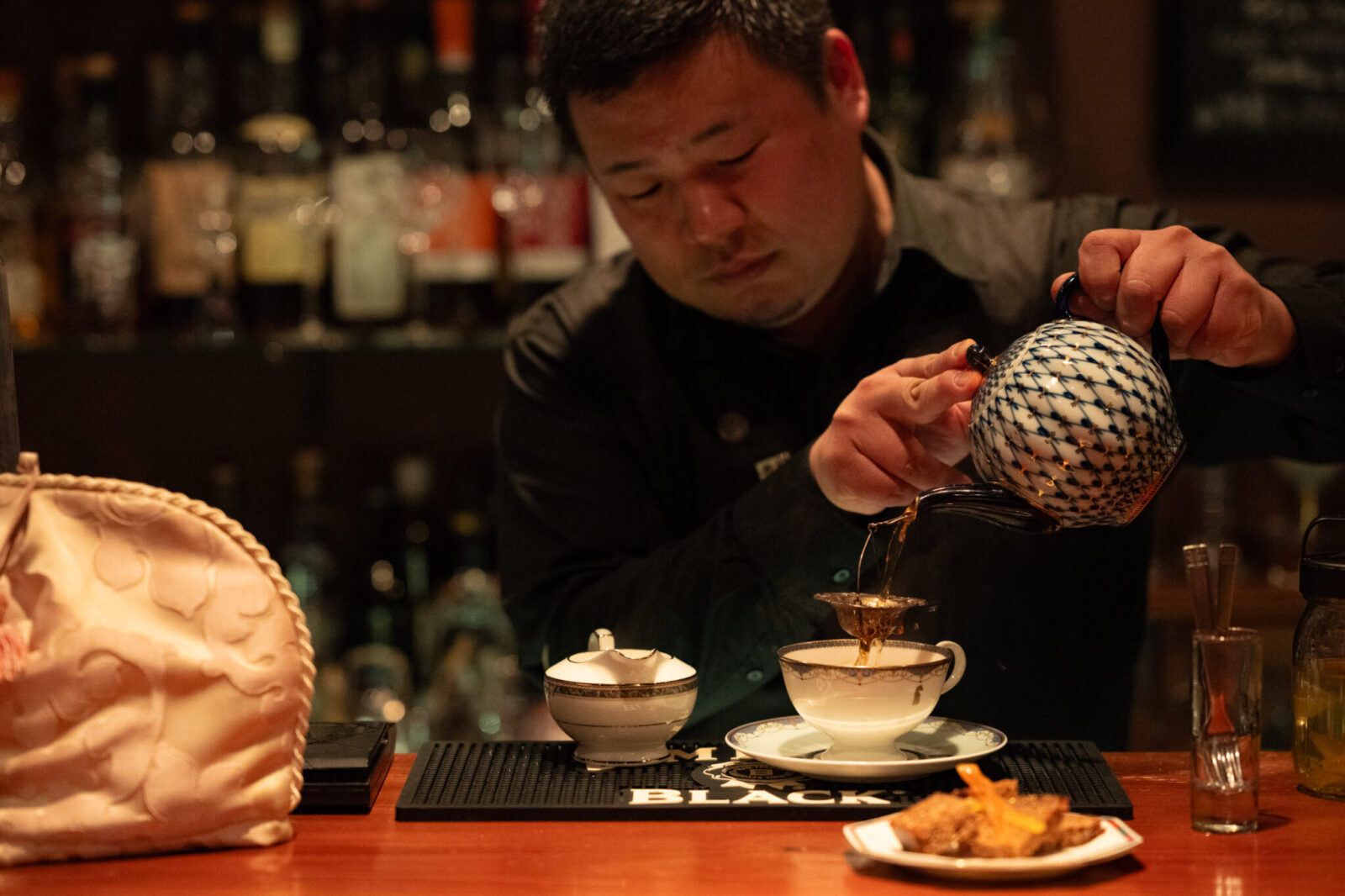
His drinks tell a story unique to this land, skillfully highlighting the best of the local ingredients while adding his own distinctive touches.
The final drink he prepared was an old-fashioned mixed juice, a specialty of the Kansai region. It offered a nostalgic, comforting flavor with a refined, sophisticated twist, embodying the elegance that only a bar can offer.
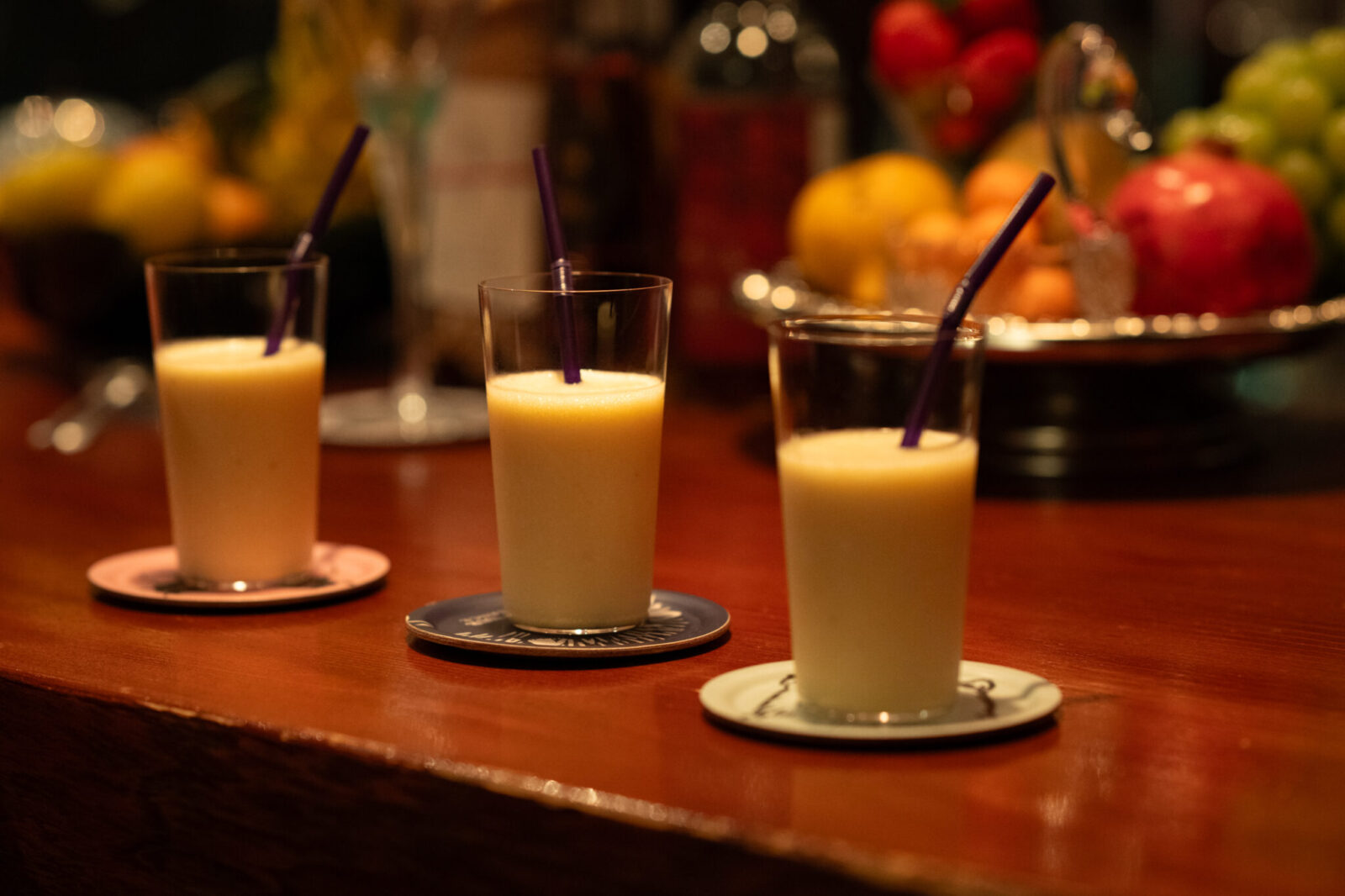
“”In Wakayama, people often give you citrus fruits for free—sometimes by the crate. It can be a challenge to finish them all! Mandarin oranges are a great tool for communication because people can share them and enjoy them on the spot.”
Throughout the day, we noticed citrus fruits served in generous slices at every izakaya we visited, accompanying everything from sashimi to deep-fried dishes.
At a beer brewery we stumbled upon, they even gave us a bundle of mandarins to take home.
We truly experienced the deep-rooted citrus culture of Wakayama Prefecture, seamlessly woven into the everyday life of the locals.
Bar Oct.
NANKAIRO Bldg. 1F, 996 Minato, Tanabe City, Wakayama Prefecture
090-5055-2694
Translation: Sophia Swanson
Advisor to corporations, and local governments on promoting local tourism. Published work includes, “Aomori & Hakodate Travel Book” (Daimond), “San’in Travel: Craft and Food Tour” (Mynavi), “A Drunkard’s Travel Guide: Sake, Snacks, and Tableware Tour” (Mynavi). Her life work is to explore towns in her travels, drink at different shops and visit the workshops of different crafts. Interests include tea, the Jomon period, architecture, and fermented foods.
Editor. Born and raised in Kagoshima, the birthplace of Japanese tea. Worked for Impress, Inc. and Huffington Post Japan and has been involved in the launch and management of media after becoming independent. Does editing, writing, and content planning/production.
